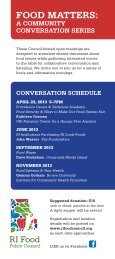PolicyLinkvouchers. Community organizations canpromote s<strong>to</strong>res that offer healthier food.• Connect s<strong>to</strong>res with governmentresources. Financial <strong>and</strong> technical assistancefor small businesses can be targeted<strong>to</strong> small-scale retailers in low-incomecommunities who are willing <strong>to</strong> improve theirselection of healthy foods. Local economicdevelopment <strong>and</strong> health departments mayalso be able <strong>to</strong> support these efforts.Start <strong>and</strong> SustainFarmers’ Markets<strong>Food</strong> at farmers’ markets is generally fresh <strong>and</strong>of high quality, <strong>and</strong> prices are often lower thanat grocery s<strong>to</strong>res. 6 Farmers’ markets can provideentrepreneurial opportunities for residents <strong>to</strong>sell baked goods, jams, crafts, or other goods.This vending requires very low start-up capital<strong>and</strong> can be a good pathway <strong>to</strong> upward mobility.Locating farmers’ markets in low-incomecommunities requires raising funds, attractingsufficient numbers of both vendors <strong>and</strong> cus<strong>to</strong>mers,<strong>and</strong> installing technology needed for acceptingpublic benefits through the Electronic BenefitsTransfer (EBT) system, which allows SNAPparticipants <strong>to</strong> purchase goods using an EBTcredit card. Farmers must find ways <strong>to</strong> keep priceslow enough for low-income consumers whilemaking enough money for their own livelihood.Some strategies <strong>to</strong> address these challenges:• Link farmers <strong>to</strong> retail opportunities.Community organizing <strong>to</strong> get cus<strong>to</strong>mers<strong>to</strong> farmers’ markets, <strong>and</strong> programs thatconnect farmers <strong>to</strong> public schools, universities,hospitals, correctional facilities, <strong>and</strong>restaurants can increase profit margins.• Increase use of EBT cards, WIC cash valuevouchers, <strong>and</strong> WIC <strong>and</strong> Senior Farmers’Market Nutrition Program coupons. Statescan exp<strong>and</strong> on successful pilot programs <strong>and</strong>capitalize on supplemental funds from theUnited States Department of Agriculture (USDA)<strong>to</strong> provide free wireless EBT equipment <strong>and</strong>service <strong>to</strong> farmers’ markets, waive transactionfees, train workers <strong>to</strong> use the equipment, <strong>and</strong>promote the markets <strong>to</strong> food stamp recipients.Starting in some states in 2010, WIC recipientscan use their WIC cash value vouchers <strong>to</strong> buyfresh fruits <strong>and</strong> vegetables at farmers’ markets.More states should establish policies <strong>to</strong> ensurethat WIC cash value vouchers, along with WIC<strong>and</strong> Senior Farmers’ Market Nutrition Programcoupons, are accepted at farmers’ markets.• Support farmers’ collaboratives<strong>and</strong> technical assistance. Farmers canshare the costs of cold s<strong>to</strong>rage facilities,transportation, <strong>and</strong> marketing. Targetedtechnical assistance programs can helpfarmers more effectively market theirproduce <strong>and</strong> manage their businesses.Connect Local Farmers <strong>to</strong>Low-Income ConsumersBeyond farmers’ markets, there are other ways<strong>to</strong> connect farmers <strong>and</strong> low-income communitiesfor the benefit of both groups. These approachesinclude urban farming, community gardens,<strong>and</strong> community supported agriculture (CSA), inwhich participants buy shares at the beginningof a growing season in exchange for boxes ofproduce from the farm throughout the season.These strategies provide access <strong>to</strong> high-quality,local healthy food, <strong>and</strong> keep food dollars inthe local community or region. These effortsalso sometimes increase interactions betweenurbanites <strong>and</strong> rural residents, <strong>and</strong> in the caseof community gardening, provide opportunitiesfor physical activity <strong>and</strong> social connections <strong>to</strong>neighbors. Challenges <strong>to</strong> these efforts includel<strong>and</strong> access, start-up <strong>and</strong> operating costs, <strong>and</strong>poor soil quality. For CSAs, additional challengesinclude cus<strong>to</strong>mers’ difficulty rounding up lump-sumpayments at the beginning of the growing season,cus<strong>to</strong>mers’ lack of control over the amount or typeof crops produced, <strong>and</strong> CSA’s difficulty acceptingpublic benefits. To address these challenges,the following strategies are recommended:8 <strong>Healthy</strong> <strong>Food</strong>, <strong>Healthy</strong> Communities
PolicyLinkCommunity Supported Agriculture• Offer reduced rate membership shares,installment plans, <strong>and</strong> work sharesfor low-income households. Theseoptions make high-quality produce moreaffordable. Reduced rate memberships can besubsidized by more affluent CSA members.• Ensure that CSAs can accept EBT, WICcash-value vouchers, <strong>and</strong> Senior <strong>and</strong>WIC Farmers’ Market Nutrition Programvouchers. Some CSAs have been able <strong>to</strong>accept EBT by allowing people <strong>to</strong> pay for theirfood when it is picked up rather than in a lumpsum at the beginning of the growing season.States such as California, Maryl<strong>and</strong>, New York,<strong>and</strong> Vermont have instituted programs <strong>to</strong> allowfarmers’ markets <strong>to</strong> accept Senior <strong>and</strong> WICFarmer’s Market Nutrition Program vouchers,<strong>and</strong> it may be possible for CSAs <strong>to</strong> acceptthe new WIC cash-value vouchers as well.• Enact supportive local l<strong>and</strong> use policies.Local ordinances <strong>and</strong> regulations can helpfarmers acquire l<strong>and</strong> <strong>and</strong> protect it fromdevelopment. Policies can also make publicspaces available for pick-ups <strong>and</strong> for farmst<strong>and</strong>s, an alternative <strong>to</strong> traditional CSAsthat reduces costs by limiting packaging.or purchase properties <strong>to</strong> protect them asopen spaces, including community gardens.• Provide grants, low-interest loans,services, <strong>and</strong> technical assistance. Localitiescan provide grants <strong>and</strong> loans <strong>to</strong> urban farmers<strong>to</strong> invest in infrastructure development, <strong>and</strong> canprovide trash collection <strong>and</strong> compost services,access <strong>to</strong> water, as well as access <strong>to</strong> <strong>to</strong>ols <strong>and</strong>s<strong>to</strong>rage facilities. Localities can also provideincentives <strong>to</strong> promote regional food systemsthat make healthy foods available <strong>to</strong> lowincomeunderserved communities. Cooperativeextension agencies or nonprofit organizationscan promote <strong>and</strong> provide assistance <strong>to</strong>community gardens <strong>and</strong> urban farmers.Community leaders across the country havedemonstrated that barriers <strong>to</strong> healthy food retailingare not insurmountable. These efforts can improvethe health of residents <strong>and</strong> spark local economicdevelopment—<strong>and</strong> ultimately help foster healthy,prosperous communities of choice <strong>and</strong> opportunity.• Provide financing for local <strong>and</strong> regionalproducers. Localities can enact programs <strong>to</strong>promote regional food systems <strong>and</strong> equitableaccess by supporting growers who make healthyfoods available <strong>to</strong> underserved communities.Community Gardens/Urban Agriculture• Provide l<strong>and</strong>. Localities can inven<strong>to</strong>ry vacant<strong>and</strong> private lots <strong>and</strong> make this informationavailable <strong>to</strong> the public; lease lots froml<strong>and</strong>owners for agricultural purposes; leasemunicipal parcels; <strong>and</strong> clean contaminatedproperties for reuse. The Chicago City Council,for example, created a city-funded entity calledNeighborSpace that is authorized <strong>to</strong> acquire<strong>Healthy</strong> <strong>Food</strong>, <strong>Healthy</strong> Communities9



